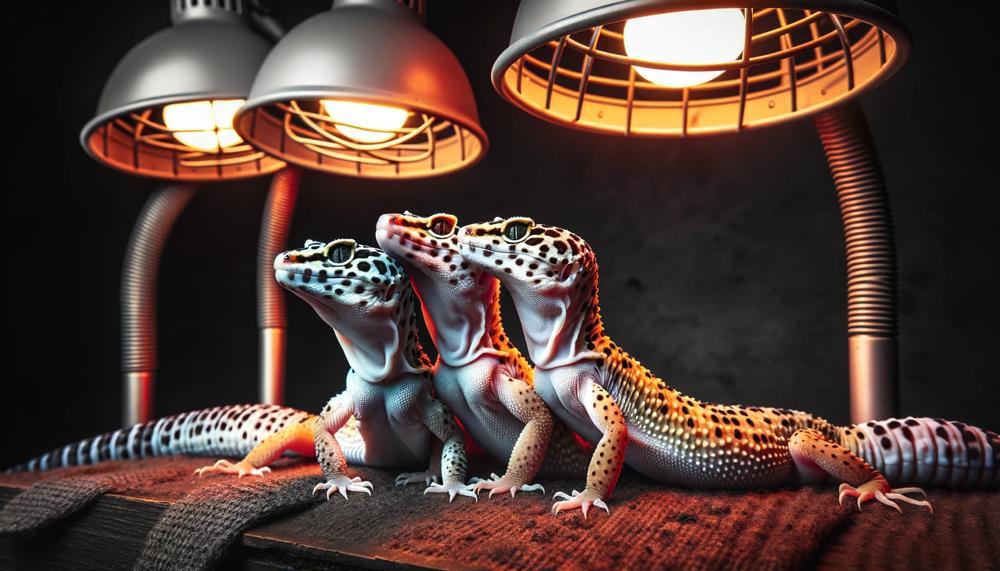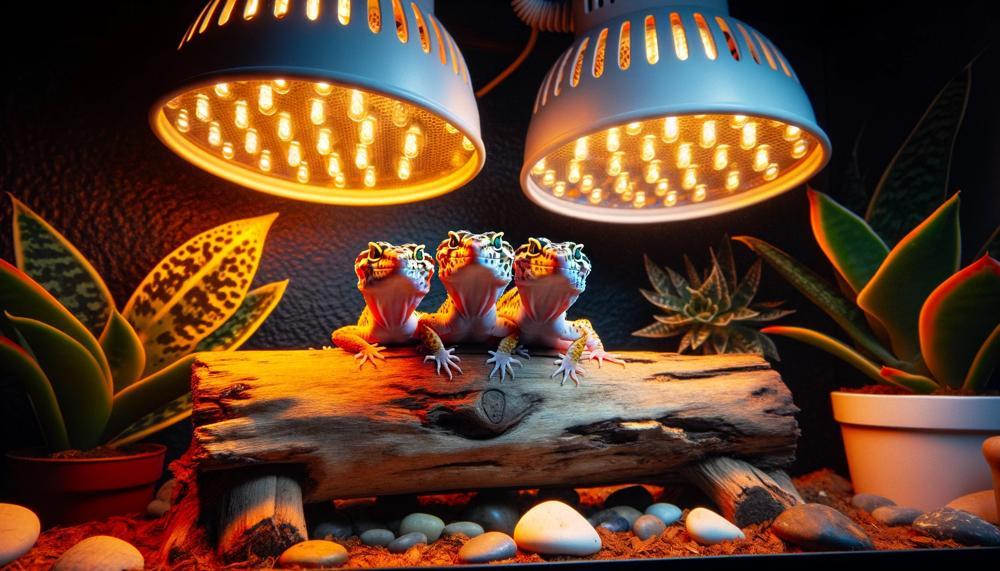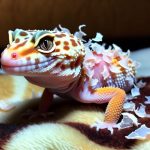Are you a proud leopard gecko owner? If so, you know that these scaly creatures require specific care to thrive and stay healthy. And one crucial item on your must-have list should be a heat lamp.
So, do leopard geckos need a heat lamp?
Leopard geckos need a heat source to digest food properly. They need heat at night, but during the day they need both heat and lighting.
Some other things you can do to heat a leopard gecko’s terrarium include:
- Using an overhead heat source
- Using an under-tank heat mat on a thermostat
- Using a ceramic bulb
- Using incandescent bulbs
- Using heating pads
- Using heat rocks
Some recommend using a heat lamp because leopard geckos need a hot side and a cold side. Others recommend using a heat mat because leopard geckos have evolved to grab heat from below, on their underside.
If your gecko doesn’t have a heat lamp or other source of supplemental heat, they can become lethargic, lose their appetite, and have a lower body temperature.
Contents
- 1 Do leopard geckos need heat?
- 2 What health risks are associated with leaving your leopard gecko in cold temperatures for long?
- 3 What are the advantages of using a heat lamp in your leopard gecko’s tank?
- 4 How do you choose a suitable heat lamp for your leopard gecko’s tank?
- 5 What do you need to install heat lamps in your leopard gecko’s tank?
- 6 What can you use instead of a heat lamp in your leopard gecko’s tank?
- 7 Can you use heat lamps and heat mats together?
- 8 What heating sources should you avoid for your leopard gecko’s tank?
- 9 What should you do when a power outage turns off your tank’s heat mats and lamps?
- 10 Conclusion
Do leopard geckos need heat?
Leopard geckos are fascinating creatures that require special care, and providing them with the right amount of heat is crucial for their overall well-being. As cold-blooded reptiles, they rely on external sources of heat to regulate their body temperature. Without proper heating, leopard geckos can become sluggish, lose their appetite, and even fall ill.
While there are various heating options available, heat lamps and under-tank heating pads are the most popular choices among leopard gecko owners. Heat lamps provide an excellent source of heat while also reducing mold growth in the tank. They are also considered safer than other heat sources as they do not emit any harmful fumes. On the other hand, heat mats are more affordable and easier to install, making them a convenient option for many pet owners.
However, it is essential to have backup measures in place in case of a power outage. This could include using a backup generator or wrapping the tank with blankets to retain heat. It is crucial to note that other heating alternatives such as fireplaces or hand warmers are not safe for leopard geckos and should never be used.
When using both a heat lamp and heating pad, it is recommended to place them on the warm side of the tank. This will allow for a suitable temperature gradient, and the geckos can move to different areas to regulate their body temperature as needed. By providing the right amount of heat, leopard geckos can thrive and stay healthy, making them happy and active pets.
What health risks are associated with leaving your leopard gecko in cold temperatures for long?
It is essential to maintain proper heating for the health and well-being of leopard geckos. As cold-blooded animals, they rely on external heat sources to regulate their body temperature and carry out necessary bodily functions. Inadequate heat can lead to various health risks for these fascinating creatures, including:
| Health Risks | Potential Effects |
| Digestive Issues | Constipation, bloating, impaction |
| Respiratory Infections | Weakened immune system, serious health complications |
| Decreased Appetite | Sluggishness, malnutrition, other health problems |
| Brumation | Dangerous if not monitored closely |
In conclusion, it is crucial to provide proper heating for your leopard gecko’s health and well-being. It is essential to monitor temperature levels in their habitat and have backup measures in place to ensure their safety.

What are the advantages of using a heat lamp in your leopard gecko’s tank?
The use of a heat lamp in your leopard gecko’s tank offers several advantages that greatly contribute to their overall health and well-being. These include preventing brumation, reducing the risk of health issues, promoting a natural day-night cycle, and providing deep core heating. In addition, heat lamps can be regulated and used in conjunction with other heating methods for optimal temperature control.
Let us delve deeper into these benefits and gain further insights into the importance of using a heat lamp in your leopard gecko’s tank.
Preventing Brumation:
Brumation is a state of hibernation that leopard geckos enter into when temperatures drop below 60 degrees Fahrenheit. While this is a natural process, it can be dangerous if they do not have enough fat reserves to sustain them.
By providing a heat lamp, the temperature in the tank remains consistently above 60 degrees, preventing brumation and keeping your gecko healthy.
Reducing Health Risks:
Leopard geckos are cold-blooded animals that rely on external heat sources to regulate their body temperature. A heat lamp provides consistent and adequate heat for essential bodily functions such as digestion and immune system functioning.
Without proper heating, they are at risk of developing health issues such as respiratory infections, impaction, and tail loss. The use of a heat lamp reduces these risks and promotes overall well-being.
Promoting Natural Day-Night Cycle:
Heat lamps can be dimmed or set on timers to mimic natural sunlight cycles, providing a sense of normalcy for leopard geckos. This promotes their natural behavior, including basking under the warm light during the day and seeking cooler temperatures at night.
A proper day-night cycle also helps regulate their sleep patterns and ensures they get enough rest.
Deep Core Heating:
Unlike other forms of heating like heat mats that only provide superficial warmth, heat lamps produce infrared waves that penetrate deeply into the gecko’s body, providing core heating.
This is essential for maintaining their body temperature and overall health.
Regulation and Optimal Heating:
Heat lamps can be regulated by adjusting their wattage or using a thermostat. The ideal wattage for a heat lamp is between 40 to 150 watts, depending on the size of the tank and gecko. Heat mats can be used in conjunction with heat lamps for optimal heating throughout the day and night.
However, it is crucial to use thermostats specifically designed for heat lamps and not for heat mats.
Backup Measures:
In case of power outages, it is important to have emergency plans in place to maintain warmth in the tank. These may include increasing the thermostat temperature or using candle space heaters.
Heat lamps also offer a safe source of heat as they are installed on top of tanks, reducing the risk of mold growth or other hazards.
How do you choose a suitable heat lamp for your leopard gecko’s tank?
When choosing a suitable heat lamp for your leopard gecko’s tank, it’s important to carefully consider several factors. These include the wattage of the heat lamp, the type of bulb used, the distance between the lamp and your pet’s tank, and ensuring the overall safety of your leopard gecko.
By taking these factors into account, you can ensure that your pet’s tank is not only adequately heated but also safe for your beloved reptile.
To begin with, wattage is a crucial factor to consider when selecting a heat lamp for your leopard gecko’s tank. The wattage of the lamp will determine the temperature of the basking area in your pet’s tank. It’s essential to select a wattage that will provide enough heat for your leopard gecko without overheating their environment. Generally, a heat lamp with a wattage between 50-60 watts is suitable for most leopard geckos. However, it’s essential to monitor the temperature in your pet’s tank and adjust the wattage accordingly if necessary.
Next, the type of bulb used in the heat lamp should also be taken into consideration. Some bulb types, such as incandescent bulbs, are more suitable for providing heat than others. It’s best to avoid LED or fluorescent bulbs as they do not emit enough heat for your leopard gecko’s tank. Instead, opt for halogen or ceramic heating bulbs as they provide more suitable levels of warmth.
The distance between the heat lamp and your leopard gecko’s tank is also an important aspect to consider. The appropriate distance will ensure that your pet’s tank is heated evenly and prevents any potential hazards such as burns or fires. As a general rule, the heat lamp should be placed at least 6-8 inches away from your pet’s tank.
Lastly, safety should always be a top priority when selecting a heat lamp for your leopard gecko. Always choose a lamp that is specifically designed for reptile use and has appropriate safety features such as a protective cage or guard to prevent your pet from coming into direct contact with the bulb.
What do you need to install heat lamps in your leopard gecko’s tank?
When installing heat lamps in your leopard gecko’s tank, it’s crucial to carefully consider the equipment you use. For example, using a UTH (under tank heater) is an excellent way to provide warmth from the ground up, mimicking the natural heat source for reptiles. A ceramic heat emitter bulb is also a great option as it produces infrared heat without emitting light, allowing for proper day/night cycles.
Additionally, using low wattage incandescent or halogen bulbs in combination with a reflector dome can provide a basking spot for your gecko.
Regularly monitoring the temperature and humidity levels in your leopard gecko’s tank is essential for their health and well-being. This is where thermometers and hygrometers come in handy. They allow you to accurately measure the temperature and humidity levels and make adjustments as needed.
It’s also recommended to have a moist hiding spot in the tank for your gecko to retreat to and maintain their preferred level of humidity.
Furthermore, it’s important to regularly maintain and replace your equipment to ensure it remains efficient and effective. This includes regularly replacing bulbs and cleaning any debris or buildup from the reflector dome.
What can you use instead of a heat lamp in your leopard gecko’s tank?
You’re in luck, as there are several options available. Some of these include heat tapes, under-tank heaters, low-level basking lights, halogen heat lamps, carbon heat projectors, ceramic heat emitters, and heat mats. However, keep in mind that not all of these options may be suitable for your tank setup and your leopard gecko’s needs.
- Heat Tapes: If you want to provide a warm spot for your leopard gecko to bask in, consider using heat tapes. These strips of heating elements can be attached to the bottom of the tank and provide gentle heat from beneath.
- Under-Tank Heaters: Similar to heat tapes, under-tank heaters are also placed beneath the tank and provide a constant source of warmth. They are easy to install and maintain.
- Low-Level Basking Lights: Mimicking the natural basking conditions of a leopard gecko, low-level basking lights offer both heat and light. For optimal temperature control, they can be used alongside other heating sources.
- Halogen Heat Lamps: Emitting a concentrated beam of heat and light, halogen bulbs are perfect for creating a basking spot for your leopard gecko. They can also be combined with other heating sources.
- Carbon Heat Projector: Using infrared technology, carbon heat projectors provide warmth without any light emission. They are energy-efficient and can be used 24/7 without disrupting your leopard gecko’s day-night cycle.
- Ceramic Heat Emitter: These long-lasting bulbs produce heat without any light emission. They are a reliable source of warmth for your leopard gecko.
- Heat Mats: Flat, electrically-heated pads that can be placed under or inside the tank, heat mats are best used alongside other heating sources to create an overall temperature gradient in the tank.
Can you use heat lamps and heat mats together?
Leopard geckos are fascinating creatures that require specific care to thrive. Providing proper heating is essential for their health and well-being. While heat lamps and heat mats are both effective sources of warmth, combining them can offer even better results. The deep-penetrating warmth from heat lamps mimics the sun’s rays, providing a natural and comfortable environment for your gecko.
On the other hand, heat mats offer superficial heating from below, keeping your gecko warm from all angles.
By using both heat sources, you can ensure that your leopard gecko has a warm and cozy habitat day and night.
Moreover, combining heat lamps and heat mats also helps regulate the temperature in your gecko’s tank more effectively. This combination prevents any sudden drops or spikes that could be harmful to your gecko’s health. It’s crucial to monitor the temperature regularly and use a thermostat to control both heat sources.
This way, you can maintain a stable temperature within the appropriate range for leopard geckos (around 85-90 degrees Fahrenheit on the warm side of the tank). By providing a consistent and comfortable environment, you are ensuring your gecko’s well-being and allowing them to thrive in their habitat.
What heating sources should you avoid for your leopard gecko’s tank?
When it comes to keeping your leopard gecko’s tank warm, hot rocks and heat mats may seem like convenient options. However, they can actually pose a danger to your pet. Let’s explore some potential risks and drawbacks of using these heating sources:
- Inconsistent heat: Hot rocks and heat mats can have varying surface temperatures, making it difficult to maintain a steady temperature in your gecko’s tank. This can cause temperature fluctuations that may stress or discomfort your pet.
- High temperatures: Heat mats and hot rocks can reach extreme temperatures, some even up to 125°F (52°C). This is much higher than the recommended temperature range for leopard geckos, which is between 88°F (31°C) to 92°F (33°C). Exposing your gecko to such high temperatures can result in thermal burns and even death.
- Risk of burns: The design of hot rocks and heat mats can lead to thermal burns on your gecko’s belly if they come into direct contact with them. This can be very painful for your pet and cause serious health issues.
- Energy consumption: Despite being advertised as energy-efficient, hot rocks and heat mats still consume a significant amount of electricity. This can add up to higher electricity bills and contribute to environmental concerns.
- Costly and unreliable: Hot rocks and heat mats can be expensive to purchase and may easily break or malfunction after just a few weeks of use. This can be frustrating and costly for pet owners.
- Fire hazards: Trying to heat up hot rocks in the microwave is not safe as it can create sparks and potentially start a fire. This poses a serious risk not only to your pet but also to your home.
To ensure the safety and well-being of your leopard gecko, it is best to avoid using hot rocks and heat mats as heating sources in their tank. Instead, consider using natural rocks or stone tiles placed under a heat lamp during the day.
This will provide a gradual release of heat at night without reaching dangerously high temperatures. Remember to always use a thermostat to regulate the temperature and keep your leopard gecko comfortable.
What should you do when a power outage turns off your tank’s heat mats and lamps?
Without these heat sources, your pet may become cold and stressed, which can lead to health problems. So, what should you do when a power outage turns off your tank’s heat mats and lamps? Here are some steps you can take to keep your leopard gecko warm and safe during this situation:
- Utilize alternative heat sources: If your regular heat sources are not functioning, you can try using other options such as space heaters or your home heating system to raise the temperature in the room where your leopard gecko’s tank is located.
- Use hot water bottles: Another option is to fill up hot water bottles and wrap them in a towel before placing them inside the tank. This will provide warmth to your pet and prevent thermal burns.
- Place the enclosure in a sunny room: If possible, move your leopard gecko’s tank into a room with plenty of windows so that natural light can enter and provide some warmth.
- Monitor the temperature: It is crucial to keep an eye on the temperature in your leopard gecko’s tank during a power outage. Make sure it stays between 70-90 degrees Fahrenheit at all times to ensure your pet’s comfort.
- Turn off heating devices if needed: If the temperature in the tank becomes too warm, make sure to turn off any heating devices to prevent overheating.
- Consider using lower-powered heating sources: If you find that your tank consistently becomes too warm during power outages, you may need to invest in lower-powered heating pads or lights to maintain the proper temperature for your pet.
Remember, the ideal temperatures for a leopard gecko’s tank are between 70-80 degrees Fahrenheit during the day and 60-70 degrees Fahrenheit at night. It is essential to keep these temperatures consistent to ensure your pet’s health and well-being.
Additionally, always have a thermometer in your leopard gecko’s tank to monitor the temperature levels.
Conclusion
In conclusion, a heat lamp is an indispensable tool for leopard gecko owners to provide their scaly companions with proper care and ensure their overall well-being.
As cold-blooded creatures, leopard geckos rely on external sources of warmth to regulate their body temperature. A heat lamp not only provides the necessary heat but also emits vital UVB rays for calcium absorption and preventing health issues.
It is crucial to carefully select the wattage, bulb type, and distance of the heat lamp, as well as regularly monitor the temperature in the tank. Combining a heat lamp with a heating mat can create a suitable temperature gradient for your gecko’s overall health and happiness.
So, invest in a high-quality heat lamp and regularly check your pet’s enclosure temperature for its optimal well-being.






